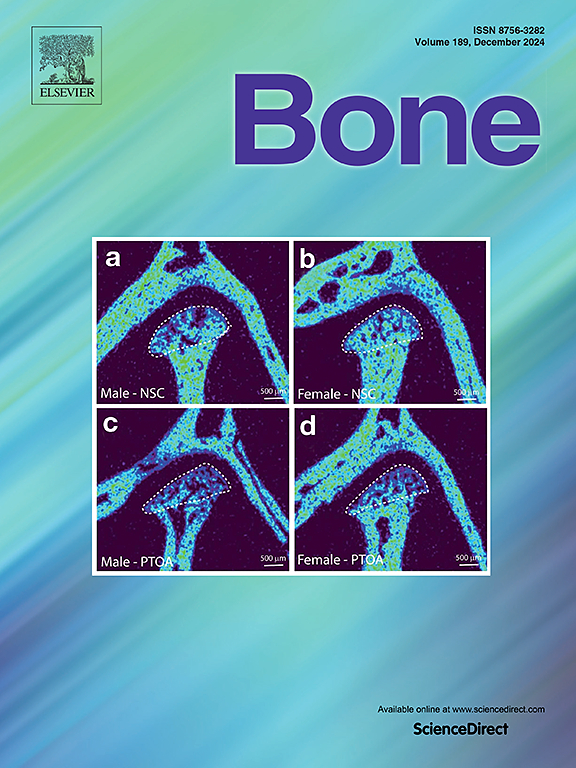Novel estrogen receptor-α gene inactivating missense variant in a woman: Therapeutic challenge and long-term follow-up data
IF 3.5
2区 医学
Q2 ENDOCRINOLOGY & METABOLISM
引用次数: 0
Abstract
Background
Rare mutations of the ESR1 gene, encoding the estrogen receptor alpha (ERα), have been shown to cause estrogen resistance in humans. Phenotypic features include impaired maturation of epiphyseal cartilage, osteoporosis, and infertility. Clinical phenotype is not well described and the available data reflect inconsistency. To date, there are no effective therapeutic options.
Method
This retrospective study provides a detailed description of bone and metabolic phenotype and 8-year follow-up data of a female with a novel p.Met543Thr missense variant in the homozygous state, localized in the ligand-binding domain.
Results
The patient, first seen at the age of 21.3 years, presented with a tall stature (+2.2 SD), a delayed bone age (13 years). She had no breast development, normal axillary and pubic pilosity and bilateral axillary acanthosis nigricans. The metabolic phenotype included insulin resistance, decreased insulin sensitivity and increased leptinemia. The patient presented a continuous linear growth (height + 3SD at the age of 28.6 years). She had a severe osteoporosis of the lumbar spine (Z-score −3.9) and osteopenia of the femoral neck (Z-score −1.8). Osteoporosis worsened (Z-score −5.6 at the lumbar spine; Z-score −4.4 at the femoral neck) despite successive treatments with ethinyl-estradiol and tamoxifen (selective estrogen modulator). Markers of bone turnover were increased and unresponsive to treatment. Treatment with ethinyl-estradiol improved insulin sensitivity, lowered leptinemia, increased some estrogen-regulated liver proteins and the E2/T ratio.
Conclusion
This report brings new insights to the estrogen resistance syndrome and improves our understanding of the skeletal and tissue specific roles of ERα in humans.
一名女性体内的新型雌激素受体-α基因失活错义变异:治疗挑战和长期随访数据
研究表明,编码雌激素受体α (ERα)的ESR1基因突变可导致人类雌激素抵抗。表型特征包括骺软骨成熟受损、骨质疏松和不孕。临床表型没有很好地描述,现有数据反映不一致。到目前为止,还没有有效的治疗方案。方法回顾性研究了1例女性p.Met543Thr错义纯合子变异(定位于配体结合域)的骨代谢表型和8年随访数据。结果患者于21.3岁首次出现,表现为身材高(+2.2 SD),骨龄延迟(13岁)。她没有乳房发育,腋窝和耻骨毛囊正常,双侧腋窝黑棘皮。代谢表型包括胰岛素抵抗,胰岛素敏感性降低和瘦素血症增加。患者28.6岁时呈连续线性增长(身高+ 3SD)。患者腰椎严重骨质疏松(z -评分- 3.9),股骨颈骨质减少(z -评分- 1.8)。骨质疏松症加重(腰椎z -评分- 5.6;尽管连续使用炔雌醇和他莫昔芬(选择性雌激素调节剂)治疗,但股骨颈z评分为−4.4。骨转换标志物增加,对治疗无反应。用乙炔-雌二醇治疗改善了胰岛素敏感性,降低了瘦素血症,增加了一些雌激素调节的肝脏蛋白和E2/T比值。结论本研究为雌激素抵抗综合征提供了新的认识,并提高了我们对ERα在人类骨骼和组织中的特异性作用的认识。
本文章由计算机程序翻译,如有差异,请以英文原文为准。
求助全文
约1分钟内获得全文
求助全文
来源期刊

Bone
医学-内分泌学与代谢
CiteScore
8.90
自引率
4.90%
发文量
264
审稿时长
30 days
期刊介绍:
BONE is an interdisciplinary forum for the rapid publication of original articles and reviews on basic, translational, and clinical aspects of bone and mineral metabolism. The Journal also encourages submissions related to interactions of bone with other organ systems, including cartilage, endocrine, muscle, fat, neural, vascular, gastrointestinal, hematopoietic, and immune systems. Particular attention is placed on the application of experimental studies to clinical practice.
 求助内容:
求助内容: 应助结果提醒方式:
应助结果提醒方式:


